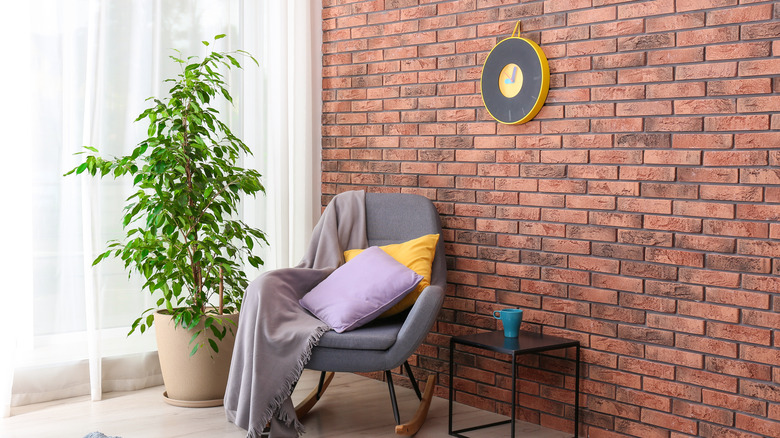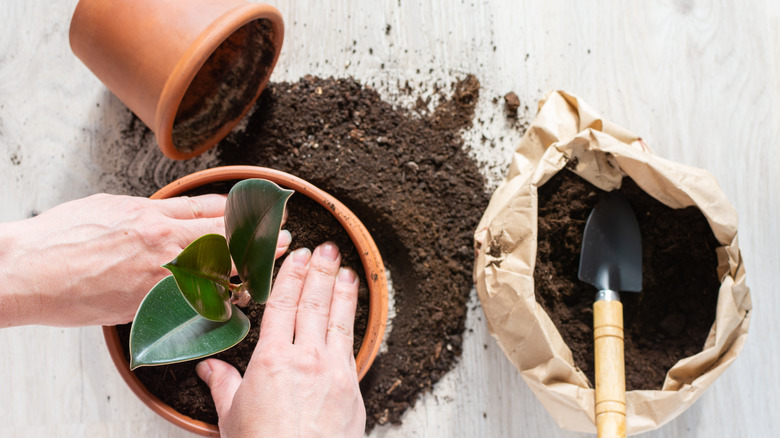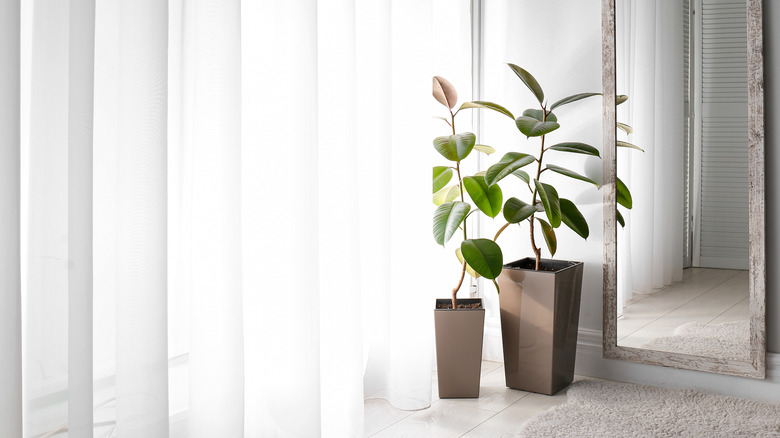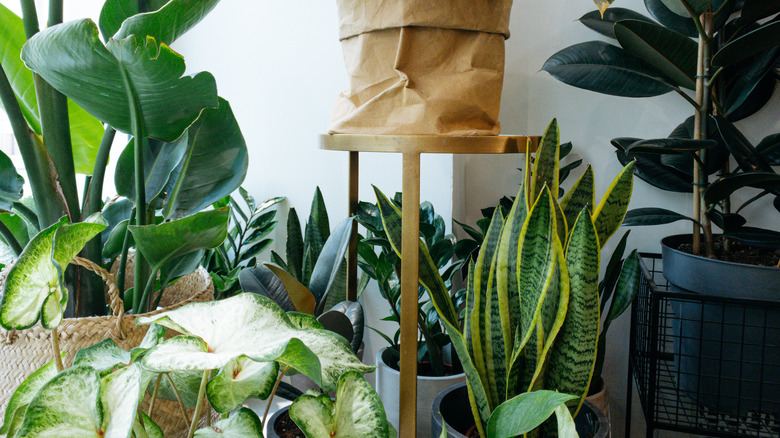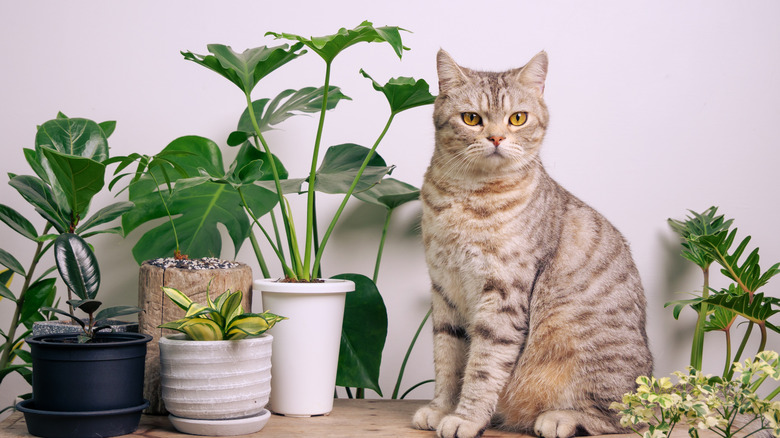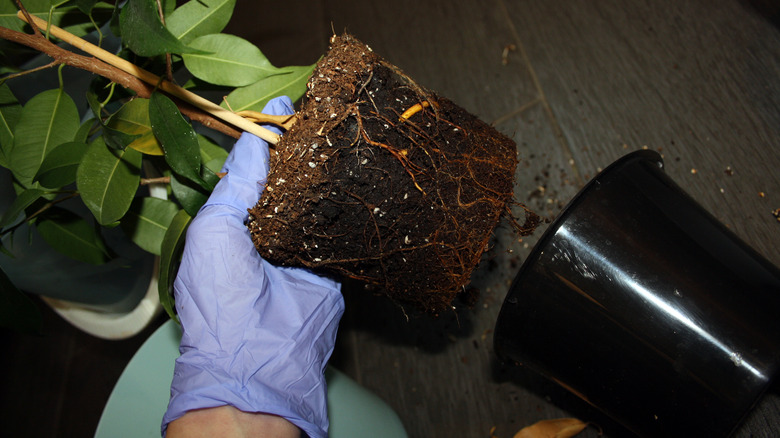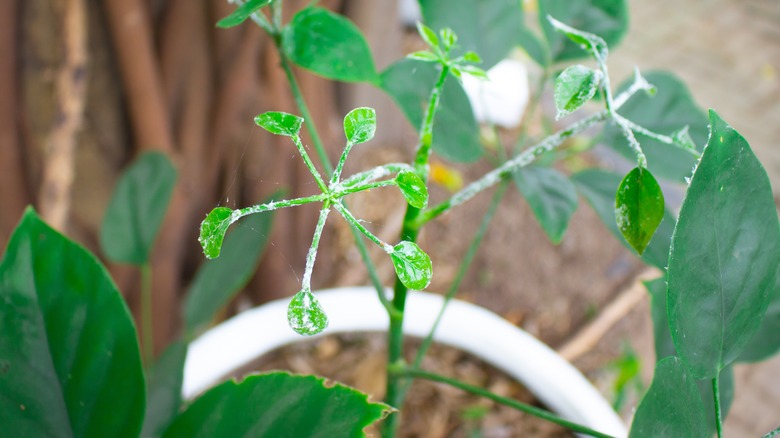How To Grow And Take Care Of Ficus Plants
While some houseplants have a "set it and forget it" kind of maintenance, the ficus family is a little fussier, needing more attention. But once you know how to nurture these gorgeous mini-trees, the extra steps needed to maintain healthy plants are totally worth your effort. They are marvelously effective as living decorative items growing in your home, and they are some of the most satisfying, show-stopping plants to have.
The Spruce describes several of the most popular ficus houseplants including Ficus benjamina or weeping fig, the plant that most resembles a small tree with glossy, symmetrical leaves about 3 inches long. The fiddle leaf fig, Ficus lyrata, originally from West Africa, has large, crinkled leaves nearly 18 inches long. The rubber tree plant, also a member of the ficus family, has thick, glossy oval leaves about 6 inches long.
Figweb indicates there are hundreds of species of ficus, or fig trees in the world, most of them native to Southeast Asia and India. Although they flourish in tropical climates, ficus plants should be placed near a sunny spot, but not in direct sunlight. Since most of the U.S. enjoys a few weeks of tropical-like weather in summer, an indoor ficus can be moved outdoors to decorate a patio. But ficus plants are creatures of habit and doesn't like a change of scenery. Some varieties, like rubber trees, don't mind moving as much as the weeping fig, which will drop leaves en masse when dealing with a new environment.
How to use ficus plants in garden
Growing ficus plants from seeds or a cutting can be frustratingly slow. So if you want that leafy green shape and vitality in your room right away, the fastest method is to purchase a potted ficus from a nursery or garden center. My City Plants says to be sure to consider the size of the plant since ficus comes in sizes from miniature bonsai to heights of 5 feet or more. Consider too, whether the tree will sit on the floor or on a piece of furniture. And consider the height of the furniture –- will it be a decorative step stool or a hip-high credenza? In general, the taller the plant and the wider the pot to hold it, the closer the plant should be to the floor.
Outdoors, ficus plants thrive in countries with tropical climates. In the U.S., however, ficus plants can only grow outside year-round in zones 10 and 11 in the USDA's plant hardiness map; these zones are found only in Florida, Hawaii, and southern Arizona and California. In most of the U.S., it's rare to see a free-growing ficus planted outside in a garden bed. More common here is a potted ficus that can be moved outdoors during summer months. However, moving a ficus should be carefully considered, as most ficus plants don't like change. A sudden shift in temperature, light, or moisture can cause a ficus to stress and drop a portion of its leaves.
How to grow ficus plants
It's possible to obtain ficus seeds online from growers both in the U.S. and overseas. SFGate describes how to germinate seeds. Step one: Sort seeds by placing them in water. Sterile seeds float — discard them. The fertile seeds will sink. Scatter these seeds on top of a container filled with peat mix. Allow the seeds to rest on top of the mix, and always keep the soil moist. The container should be kept indoors in indirect, bright light at 75 degrees or so. The seeds take 15 to 90 days to sprout. Once they have developed leaves, transfer individual plants into separate containers.
You can also propagate a ficus using a stem cutting, according to Houseplant411. Make a clean cut, taking a 4- to 6-inch piece from a healthy plant. Make your cut just beneath a leaf node, which is where the leaf is attached to the stem. Remove the leaves from the lowest third of the cutting. Dip the end in a rooting hormone, and pop the cutting into a container filled with potting soil. Make sure the pot has good drainage. Also, make sure to keep the soil moist at all times, but be careful not to drown the plant. Keep the pot in an area free of drafts and in indirect sunlight. After a few weeks, check for roots. The roots are in place when a gentle tug on the plant is met with resistance.
How to care for ficus plants
Apartment Therapy has tips on caring for your ficus. Besides best light conditions, consider that they thrive in temperatures 60 degrees and warmer. Be sure to keep your ficus away from extreme heat, like near heating vents in winter, or in unusually cold areas, like an air conditioner in summer. Try to place it out of drafty spaces as well -– not too close to a door to the outside, for example.
Ficus plants thrive in moist, not soaked soil -– no houseplant likes wet feet. No matter the size of your container, be sure it has drainage holes. When the top layer of soil feels dry to the touch, it's time to water. Get on a schedule, like watering every few days in spring and summer and a little less in winter. Additionally, The Spruce indicates your ficus will be happier if you mist its leaves every few weeks. Misting not only keeps the plant healthy, but it also removes dust build-up, allowing the natural gloss of the leaves to shine –- literally.
Ficus plants can stand a little trimming from time to time. Gardening Know How indicates that late summer and early fall are the best times to give too-tall branches a haircut, or thin out overly bushy growth. If your plant needs a trim, be careful and do not cut off more than 1/4 or 1/3 of the plant at any one time. Dead branches can be removed at any time.
Varieties of ficus plants
House Plant Central describes several of the most popular ficus plants available. Possibly the most iconic member of the family is the weeping fig, Ficus benjamina. A darling of '70s and '80s architecture, this is the tree seen growing in atriums across the country in retail and offices spaces. With its cloud of shiny, oval leaves topping a slender trunk, what's not to love? Just know that as beautiful as this ficus is, she's a diva and will drop leaves like crazy if hit with adverse conditions.
Another popular ficus is the fiddle leaf, Ficus lyrata. Leaves about 6 inches by 4 inches are deep green with lighter green veins, growing off a central stem. This plant appreciates bright, indirect light, and is a total humidity lover -– consider placing it in your bathroom or kitchen.
Ficus elastic, the rubber tree plant, has been developed into variegated strains that have leaves from deep green to cream and pink, and even shades of dark red. The sap or latex from this plant can mimic rubber, but its value is not in the production of material, but in its beauty. These look especially good softening an empty corner in a room.
The banyan tree is also a ficus, and though they can grow to huge proportions, brought down to scale, the Ficus "Audrey" is another lovely plant resembling its much, much larger big brother. With patience and good care, it produce lustrous oval leaves all year round.
Are ficus plants toxic?
Unfortunately, ficus plants are toxic. According to the ASPCA, ficus and related fig trees are toxic to cats, dogs, and horses, and can cause digestive upset and skin irritation. Like any toxic substance, symptoms can be mild to severe, depending on how much material is ingested. The milky-white sap found in the leaves and branches is also noxious to people and can cause eye and skin irritation. You might want to wear gloves while pruning to avoid the sticky sap.
Reference indicates that the tree's toxicity is relatively mild for human beings, usually resulting in an itchy skin rash. But for pets, the plants are potentially more harmful. Chewing the leaves can bring on bouts of diarrhea or vomiting, both of which can cause dehydration. This condition can be especially harmful to young puppies or kittens, as well as senior pets. Having a weeping fig or rubber plant may not be the best choice for households with curious pets or small children.
How to repot a ficus plant
Like any houseplant, a ficus can outgrow its pot, so to keep it healthy you may have to upgrade its living quarters every two years or so. If you see roots growing out of the pot's drainage holes or if despite your excellent care the plant seems to be failing for no good reason, the ficus probably needs to be repotted.
Ficus Conseils has valuable information on how to move your ficus to a larger "house." It's best to do this in spring when a growth spurt is natural. Get a bigger pot, one that's only 2 to 4 inches taller and wider than the current pot. (Go from M to L, not M to XXL.) Be sure there are sufficient holes in the bottom, and fill the new pot with a layer of coin-size rocks so water doesn't puddle underneath the roots. Cover that layer with a few inches of potting soil.
Gently lift the plant at its base. Carefully comb the root ball with a cultivator or your hands, removing large clumps of soil and loosening the tangled roots. Pop the plant into the new pot and scoop new soil all around it. Tamp gently to remove air pockets, then water the plant and check on the drainage. That's all the excitement a ficus can take. Return the repotted ficus to its usual spot. If you want to move it, wait until it has recovered from the repotting process.
Ficus plant pests and problems
Pests that can affect the health of the ficus tree include armored and soft scales, mealybugs, thrips, and whiteflies, says UC IMP (the University of California Agriculture and Natural Resources). All of these are tiny insects that live by sinking their "teeth" into a healthy green leaf and sucking the juices out of the plant, like itty bitty vampires. Should your ficus be invaded, while the bugs themselves are hard to see, the evidence that appears on the plant is not. One tell-tale sign of pest invasion is sticky, gold-colored drops on the leaves of the afflicted plants. "Honeydew" is solid evidence the plant is infested and needs to be treated with a product containing neem oil.
Other adverse growing conditions, such as too much or too little water, or air that's too cold, too hot, or too dry, will cause the plant to respond by dropping its leaves very quickly. When a healthy plant sheds its leaves in a day or two (yes, that quickly), pay attention to the plant's environmental factors –- the light, temperature, draftiness, and soil. Fortunately, with a little bit of extra knowledge, your ficus can bloom, grow, and look terrific for many years.

